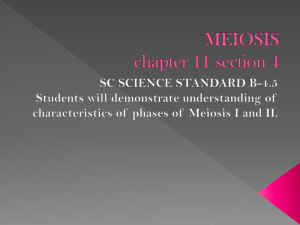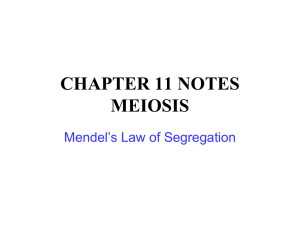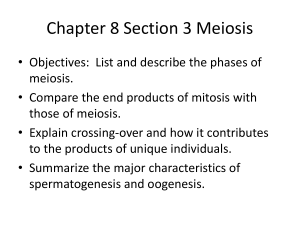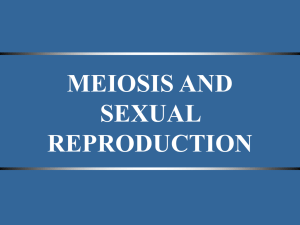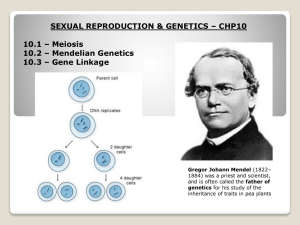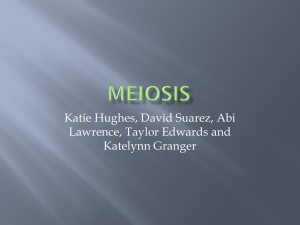File - Biology with Radjewski
advertisement
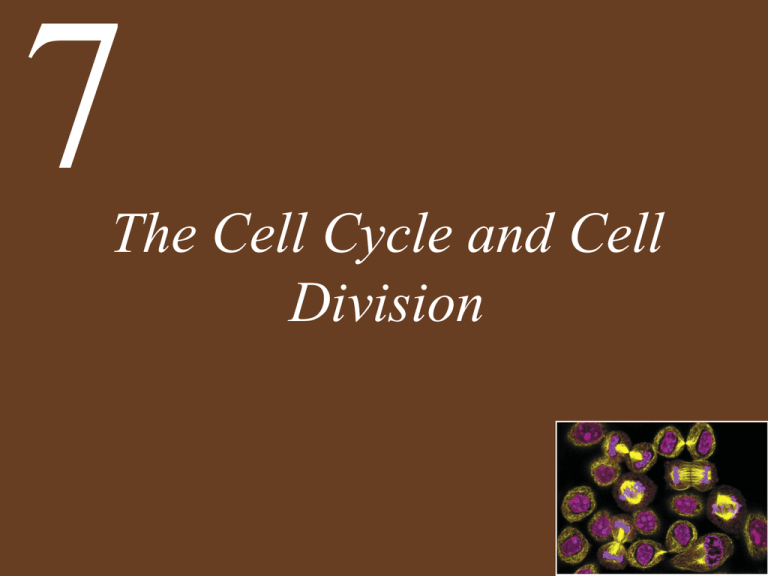
7 The Cell Cycle and Cell Division Chapter 7 The Cell Cycle and Cell Division Key Concepts • 7.4 Meiosis Halves the Nuclear Chromosome Content and Generates Diversity • 7.5 Programmed Cell Death Is a Necessary Process in Living Organisms Concept 7.4 Meiosis Halves the Nuclear Chromosome Content and Generates Diversity Meiosis consists of two nuclear divisions but DNA is replicated only once. The function of meiosis is to: • Reduce the chromosome number from diploid to haploid (2n 1n) (46 23) • Ensure that each haploid has a complete set of chromosomes • Generate diversity among the products Meiosis I • Occurs in Germ Cells • Specialized reproductive cells of the testis and ovaries • G1, S, G2 happens in Interphase • Consists of Prophase I, Metaphase I, Anaphase I and Telophase/Cytokinesis I Prophase I • Homologous Chromosomes pair up (tetrads) and do crossing over • Genes from Mom and Dad’s chromosomes swap • Called synapsis – pieces of the chromsomes actually break off and swap locations at chiasmata • Creates genetic diversity • Explains why you don’t look exactly like your parents or siblings • Nuclear membrane and nucleolus disappear and centrosome/spindle fibers start to organize Figure 7.13 Crossing Over Forms Genetically Diverse Chromosomes Metaphase I •Homologous Chromosome Pairs line up at the equatorial plate Anaphase I •Homologous Pairs of chromosomes split into regular chromosomes •At this point, chromosome number is reduced. 2n 1n Telophase and Cytokinesis I • Chromosomes reach poles • Nuclear membrane and nucleolus reappear • Cytokinesis separates the cytoplasm • Both cells have half the number of chromosomes as the parent cell • DNA Replication will not occur between divisions, just an intermission occurs Meiosis II • Prophase II, Metaphase II, Anaphase II, Telophase II • Follows same sequence of events as mitosis • Prophase II – chromosomes become visible, nuclear membrane and nucleolus disappear, centrosome and spindles organize • Metaphase II – chromosomes line up at equator • Anaphase II – Chromosomes split into chromatids and get pulled to opposite poles by the spindle fibers • Telophase II – chromatids become chromatin and we now have 4 CELLS! Figure 7.12 Meiosis: Generating Haploid Cells (Part 4) Meiosis Products Males - Spermatogenesis •4 mature sperm are made •Each sperm have 23 chromosomes •Each sperm also develop flagella for movement towards fertilization Females - Oogenesis •1 large egg or ova is produced that survives •3 small polar bodies are produced which don’t survive due to lack of nutrients due to lack of cytoplasm Figure 7.11 Mitosis and Meiosis: A Comparison Mitosis Meiosis •Asexual reproduction •1 division •Done by all somatic cells •Identical daughter cells produced •No crossing over = no genetic diversity •2n 2n •How cells reproduce, repair and how organisms grow •Sexual reproduction •2 divisions •Done by germ cells •4 gametes are produced •Crossing over – genetic diversity •2n 1n •How sperm and ova are made Concept 7.4 Meiosis Halves the Nuclear Chromosome Content and Generates Diversity Meiotic errors: Nondisjunction—homologous pairs fail to separate at anaphase I—sister chromatids fail to separate, or homologous chromosomes may not remain together Either results in aneuploidy—chromosomes lacking or present in excess Example: Down syndrome Concept 7.4 Meiosis Halves the Nuclear Chromosome Content and Generates Diversity Organisms with triploid (3n), tetraploid (4n), and even higher levels are called polyploid. This can occur through an extra round of DNA duplication before meiosis, or the lack of spindle formation in meiosis II. • Polyploidy occurs naturally in some species, and can be desirable in plants. • Produces larger flowers, fruits and seeds for example Concept 7.4 Meiosis Halves the Nuclear Chromosome Content and Generates Diversity If crossing over happens between nonhomologous chromosomes, the result is a translocation. A piece of chromosome may rejoin another chromosome, and its location can have profound effects on the expression of other genes. Example: Leukemia Concept 7.5 Programmed Cell Death Is a Necessary Process in Living Organisms Cell death occurs in two ways: 1.In necrosis, the cell is damaged or starved for oxygen or nutrients. The cell swells and bursts. 2.Apoptosis – genetically programmed cell death Reasons for this? Cell is no longer needed Genetic damage/cancerous Concept 7.5 Programmed Cell Death Is a Necessary Process in Living Organisms Events of apoptosis: • Cell detaches from its neighbors • Cuts up its chromatin into nucleosome-sized pieces • Forms membranous lobes called “blebs” that break into fragments • Surrounding living cells ingest the remains of the dead cell Figure 7.14 Apoptosis: Programmed Cell Death (Part 1) Concept 7.5 Programmed Cell Death Is a Necessary Process in Living Organisms Cell death cycle is controlled by signals: • Lack of a mitotic signal (growth factor) • Recognition of damaged DNA

